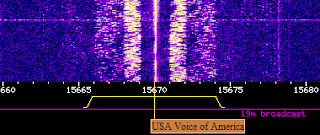From Kim Elliott:
Hello friends,
Have your lab coats ready, because VOA Radiogram for the weekend of 30 November and 1 December will full of experiments.
The first experiment has to do with last weekend's slanted MFSK images. On Saturday, all listeners experienced badly slanted MFSK images. Merkouris, SV2HWM, in Greece quickly offered a solution by adjusting the sound card offset in Fldigi. I emailed this information to the group. Based on your responses, we agreed that a correction of -2250 ppm (parts per million), give or take depending on your sound card, produced the best results.
I still don't know what caused the slant, but if a correction of -2250 ppm was necessary, this indicates that something on the VOA side was 0.225% too fast. This discrepancy in speed did not affect the decoding of the text, only the MFSK images.
This weekend we will begin the program with an image of a single vertical blue line, transmitted three times for a total of 2 minutes, 15 seconds:
In Fldigi, open this box: Configure > Sound Card > Settings. Set the RX Corrections to 0 (zero) or to whatever setting you use normally. As the vertical line is transmitted, if it is not vertical, try a different ppm setting, then click Save. Repeat this process until you have a vertical line.
If the calibration is as bad as it was last week, with the top of the line slanting to the right like the image below, you will need another correction of -2250 (minus 2250) ppm, more or less:

If the slant to the right is less severe, as below, a correction of -1000 ppm should work:

If the top of the line slants to the left, as below, try a correction of 1000 (positive 1000) ppm:

Audio Harmonics
Our second experiment involves the audio harmonics that many of you have noticed during VOA Radiogram broadcasts. They are sometimes noticeable on the Fldigi waterfall. For example, in the image below, the MFSK32 fundamental is from 1250 to 1750 Hz, with the bottom half of the second audio harmonic visible starting at 2500 Hz. It is actually from 2500 to 3500 Hz:

The transmitter in North Carolina is operating according to specifications, but there will always be some degree of audio harmonics. They are more noticeable with the digital text modes because the fundamental RF is very fixed between two frequencies, rather than diffused over a wide range as in voice transmissions.
The audio harmonics generally do not seem to impair the decoding of the text modes. For example, MFSK64 with our typical center frequency of 1500 Hz extends from 1000 to 2000 Hz, with the second harmonic safely out of the way from 2000 to 4000 Hz. Below is the MFSK64 as spectrally displayed on the University of Twente SDR receiver in the Netherlands. The fundamental in this double-sideband AM signal is 15668-15669 and 15671-15672 kHz, with second harmonics at 15666-15668 and 15672-15674 kHz:

Robert, KK5VD, in Alabama suggested this experiment: If we move the center frequency of MFSK64 to 1000 Hz, the fundamental will extend from 500 to 1500 Hz. The second harmonic will be from 1000 to 3000 Hz, so there will be an overlap. Will this have a negative effect on the decoding of the MFSK64? We will investigate this question by transmitting the same VOA News story in MFSK64 centered on 1500 Hz, followed by the same story in MFSK64 centered on 1000 Hz. We will repeat the experiment using the new long-interleave mode MFSK64L.
Here is the lineup for VOA Radiogram, program 35, 30 November/1 December 2013:
1:37 MFSK16: Program preview (3:01)
4:43 MFSK32: Slant test with 4 images (5:18)
10:03 MFSK32: Introduction to audio harmonic experiments (2:32)
12:33 MFSK64 1500Hz/1000Hz: Philippines radio (3:56)
16:27 MFSK64 1000Hz: W7VOA image (1:55)
18:24 MFSK32: Email address and intro to MFSK64L tests (:44)
19:08 MFSK64L 1500Hz/1000Hz: Ivanpah solar power station (5:30)
24:39 MFSK32: Image of Ivanpah facility (2:37)
27:13 MFSK32: Closing announcements (:32)
27:46 MFSK32: VOA Radiogram logo (:36)
Please send reception reports to radiogram@voanews.com
VOA Radiogram transmission schedule
(all days and times UTC)
Sat 1600-1630 17860 kHz
Sun 0230-0300 5745 kHz
Sun 1300-1330 6095 kHz
Sun 1930-2000 15670 kHz
All via the Edward R. Murrow transmitting station in North Carolina.
Thanks to all of you who sent reception reports for last weekend's VOA Radiogram. I will begin answering those reports today, as I digest Thanksgiving dinner.
I look for forward to hearing from you this weekend.
Kim
Kim Andrew Elliott
Producer and Presenter
VOA Radiogram
voaradiogram.net
